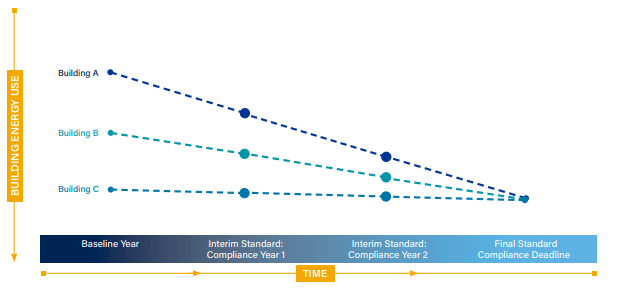In April 2021, Montgomery County, Maryland introduced its Building Energy Performance Standard (BEPS) legislation to the County Council. If adopted, the legislation would make Montgomery County the first county and the fifth jurisdiction nationwide to enact a building performance standard. Building performance standards (BPS) are mandatory ordinances that set clear targets for existing building performance and offer a way to meaningfully reduce emissions while increasing building operations efficiency, lowering costs and creating local jobs. IMT has played a close role in helping support Montgomery County’s milestone and our own BPS model ordinance is based in part on the “trajectory approach” innovation embedded in the County’s proposed ordinance.
Currently, Montgomery County’s buildings are responsible for 50 percent of its greenhouse gas emissions. The County’s push for a BPS began when the County’s Department of Environmental Protection (DEP) realized that significant building energy reductions would be needed to achieve the County’s goal of carbon neutrality by 2035. In autumn 2019, the County joined the City Energy Project, a joint project of IMT and the Natural Resources Defense Council, to receive technical support in developing BEPS legislation.

In February 2020, DEP initiated a stakeholder engagement process to examine potential elements of a performance standard. In a series of five meetings, the stakeholder group—which included representatives from the commercial and multifamily real estate industries, affordable housing, environmental advocacy groups, utilities, and energy contractors—worked together to develop recommendations for the design of an ambitious, equitable, and effective building performance standards policy.
The County’s proposed ordinance, based on these stakeholder recommendations, applies energy use intensity standards to all County-owned, commercial, and residential buildings 25,000 square feet and larger. The ordinance’s central innovation is its “trajectory approach,” that uses a combination of long- and short-term performance standards to provide building owners with regulatory certainty and appropriate flexibility to accommodate typical capital planning cycles, while still pushing owners to improve their properties at the earliest opportunity.
In the trajectory approach, buildings are sorted by property type and each property type is assigned a long-term final performance standard according to a performance metric. In Montgomery County, the metric is based on a building’s site energy use intensity (kBTU/sf) less any renewable electricity the building generated onsite. All buildings within a property type must meet the same final performance standard by the designated compliance deadline. In Montgomery County, the final standard’s deadline will be 2034, 2036, or 2037, depending on the type and size of the building.
Buildings will also be required to meet interim standards every four years to ensure their progress toward the final standard. Each building’s interim performance levels are determined by its individual performance trajectory. DEP will use a simple spreadsheet to calculate each building’s trajectory by drawing a straight line from the building’s baseline performance to the final standard. This approach allows better-performing buildings to improve more gradually than poorer-performing buildings, which despite being expected to improve more quickly are permitted to use more energy at every interim standard. For a visual representation of the trajectory approach, see the diagram below depicting three hypothetical buildings of the same property type.

The final performance standard for each property type, as well as other policy details, are not included in Montgomery County’s proposed BEPS legislation, which describes the main parameters and timing of the policy. After successful adoption of the BEPS law, the County will embark on a process to adopt regulations establishing the numerical performance standards, guidance for onsite solar generation, adjustments and assistance for under-resourced building sectors, and other administrative details.
Montgomery County’s efforts to develop BEPS were not deterred by the COVID-19 pandemic—which broke out in the middle of its stakeholder engagement process. While the County recognizes the economic hardship the pandemic and its response has imposed on businesses in the County, the County also acknowledges that failing to act on existing buildings’ contributions to climate change would have even greater long-term negative consequences. Instead, the County recognized that making energy improvements to buildings would generate a huge amount of economic activity, accelerate the County’s economic recovery, and make buildings more resilient to future stressors.
In recognition of the financial difficulty that some building owners may face in meeting the performance standard, the County has committed to providing technical assistance, favorable financing tools and, where appropriate, financial incentives, to help building owners comply with BEPS. Additionally, if the legislation is adopted by the County Council, Montgomery County and neighboring Washington, DC would have an opportunity to collaborate on a regional level to support building owners and the contractors that serve them through financing programs, technical assistance, and facilitating the exchange of best practices among owners, contractors, utilities, and other stakeholders.
To learn more about building performance standards, visit imt.org/bps.
To learn more about Montgomery County’s BEPS and access the full legislative packet, visit the County’s website.
